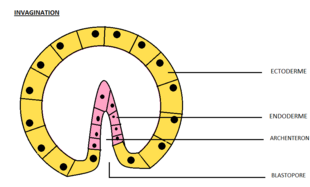Invagination in Biology
- Invagination is the initial step of gastrulation, which is the massive reorganization of the embryo from a simple spherical ball of cells into a multi-layered organism with differentiated germ layers.
- Invagination also occurs later in embryonic development, such as the invagination of the inner membrane of a mitochondrion to form cristae, providing a larger surface area for ATP production.
- Invagination is involved in endocytosis and exocytosis when a vesicle forms within the cell and the membrane closes around it.
- Intussusception is the invagination of a part of the intestine into another part.
- Invagination plays a crucial role in the morphogenetic processes of embryonic development.
Invagination in Amphioxus
- Invagination in Amphioxus is the first cell movement of gastrulation.
- During gastrulation, the blastula undergoes invagination, transforming into a cup-shaped structure with a double wall.
- The inner wall, called the archenteron, becomes the primitive gut, while the outer wall becomes the ectoderm.
- The archenteron opens to the exterior through the blastopore.
- The invagination process in Amphioxus is described as the folding of the endoderm towards the inner part of the embryo.
Invagination in Tunicates
- Invagination is the first mechanism that takes place during gastrulation in tunicates.
- The invagination process involves internal movements of the endoderm cells, resulting in changes in their shape.
- The blastula of tunicates undergoes a change of shape from columnar to wedge-shaped during invagination.
- Once the endoderm cells are invaginated, they continue to move beneath the ectoderm.
- The invagination process in tunicates is complete with the formation of the blastopore surrounded by the mesoderm.
Invagination in Geology
- In geology, invagination refers to a deep depression of strata.
- Donald L. Baars used the term invagination to describe such depressions in The Colorado Plateau.
- Invagination in geology is a significant geological feature.
- It is used to understand the structural characteristics of rock formations.
- The study of invagination in geology provides insights into the geological history of an area.
References
- Gilbert, Scott; Rauno, Anne. Embryology, Constructing the Organism.
- Gilbert, Scott; Barresi, Michael. Developmental Biology.
- Davies, Jamie A. Mechanisms of Morphogenesis.
- Alberts. Molecular Biology of the Cell.
- Cronk, Jeff. Biochemistry Dictionary.
Invagination is the process of a surface folding in on itself to form a cavity, pouch or tube. In developmental biology, invagination is a mechanism that takes place during gastrulation. This mechanism or cell movement happens mostly in the vegetal pole. Invagination consists of the folding of an area of the exterior sheet of cells towards the inside of the blastula. In each organism, the complexity will be different depending on the number of cells. Invagination can be referenced as one of the steps of the establishment of the body plan. The term, originally used in embryology, has been adopted in other disciplines as well.

There is more than one type of movement for invagination. Two common types are axial and orthogonal. The difference between the production of the tube formed in the cytoskeleton and extracellular matrix. Axial invagination can be formed at a single point along the axis of a surface. Orthogonal invagination is linear and trough.
From invaginate + -ion.
invagination (countable and uncountable, plural invaginations)